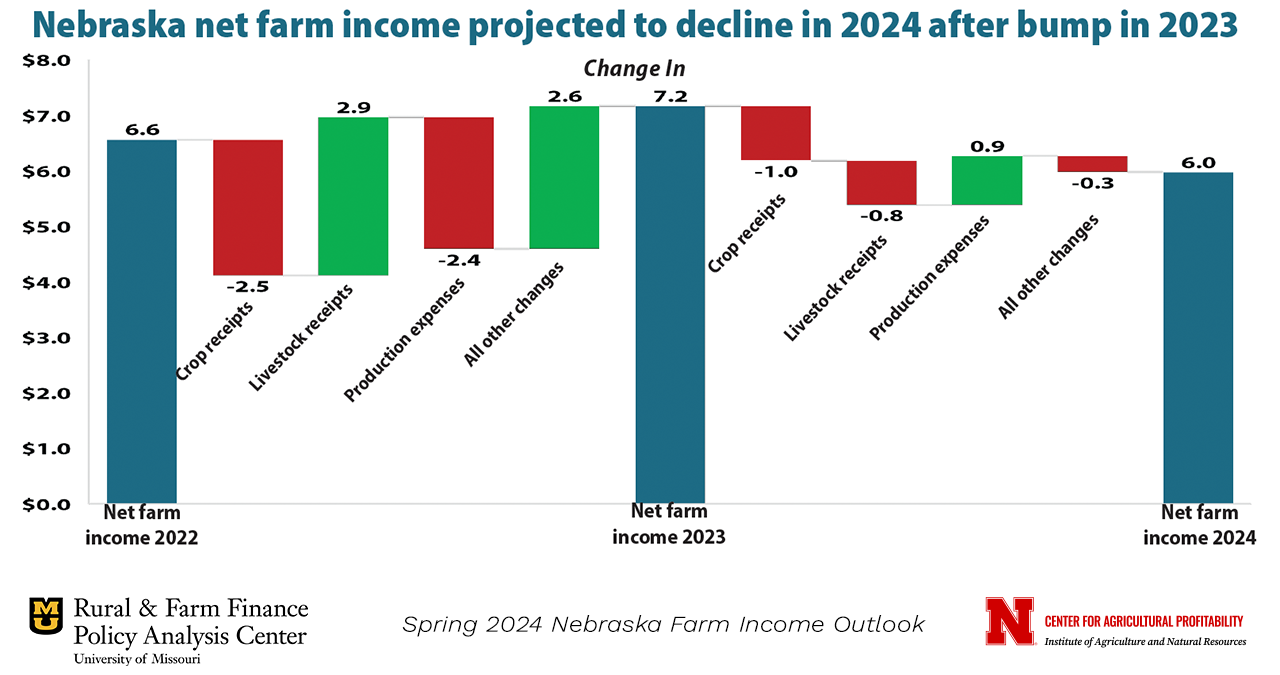Nebraska’s net farm income is projected to fall to $6 billion in 2024 and average $6.3 billion per year across the next decade, according to a new report from the Rural and Farm Finance Policy Analysis Center (RaFF) at the University of Missouri, produced in conjunction with the Center for Agricultural Profitability at the University of Nebraska-Lincoln.
While U.S. farm income projections topped a 2021 record with a new record in 2022 before falling in 2023, Nebraska net farm income took a fall in 2022, to $6.6 billion, before partially rebounding in 2023, to $7.2 billion.
“Producers are feeling the pinch of declining farm income in 2023, with a further drop expected in 2024, but the projection to fall to $6 billion this year is a still a relatively strong farm income number, compared to the past decade and builds on a solid financial position for agriculture in the state as a whole,” said Brad Lubben, an extension agricultural policy specialist with the Center for Agricultural Profitability and a contributor to the report.
The projected decline is attributed to a downturn in crop receipts in the state — due to lower crop prices in 2023 — that look to fall further in 2024. Livestock receipts grew in 2023 on the strength of cattle prices but look to decline in 2024 with reduced cattle marketings and further declines in other livestock commodities, the report said.
While production expenses remained high in 2023, the report projects that the costs of feed, fertilizer, and fuel, along with interest rates, are expected to drop in 2024, helping to offset some of the impact of lower commodity receipts in Nebraska.

Other highlights from the report include:
- After persistent drought conditions in Nebraska, the forecast of average yields in 2024 results in increases in crop production. Despite increased production projected in 2024, lower commodity prices are expected to reduce 2024 crop receipts by 7%, with projections indicating further reductions in 2025 and 2026.
- Corn planted acreage is anticipated to shrink 240,000 acres in 2024, but an expected return to trend yields allows corn production to increase this year. However, lower corn prices are expected to reduce receipts by $1 billion in 2024.
- Soybean acres climb in 2024, with planted area projected to increase by roughly 472,000 acres from 2023. Higher yields drive production higher, but lower prices cause soybean receipts to decline slightly in 2024.
- After experiencing herd liquidation in 2022, Nebraska cattle and calf inventory fell again during 2023. With improved forage conditions, cattle inventory is projected to grow modestly during 2024.
- Despite higher prices, declining marketings are projected to cause cattle and calf receipts to drop an estimated $0.7 billion in 2024. Total cattle marketings are forecast to decline nearly 6% from 2023. Cattle prices are projected to peak in 2026 and marketings begin to increase in 2025.
The spring 2024 farm income outlook is co-published by the University of Nebraska-Lincoln Center for Agricultural Profitability and RaFF at the University of Missouri, which provides objective policy analysis and informs decision-makers on issues affecting farm and rural finances. The center collaborates with a number of states to develop farm income projections with local expertise.
The Nebraska Farm Income Outlook report is available at https://cap.unl.edu/farm-income.
A webinar covering 2024 Nebraska and U.S. Farm income and outlook will be held at noon Central time on April 18, with registration accessible on the same page.





